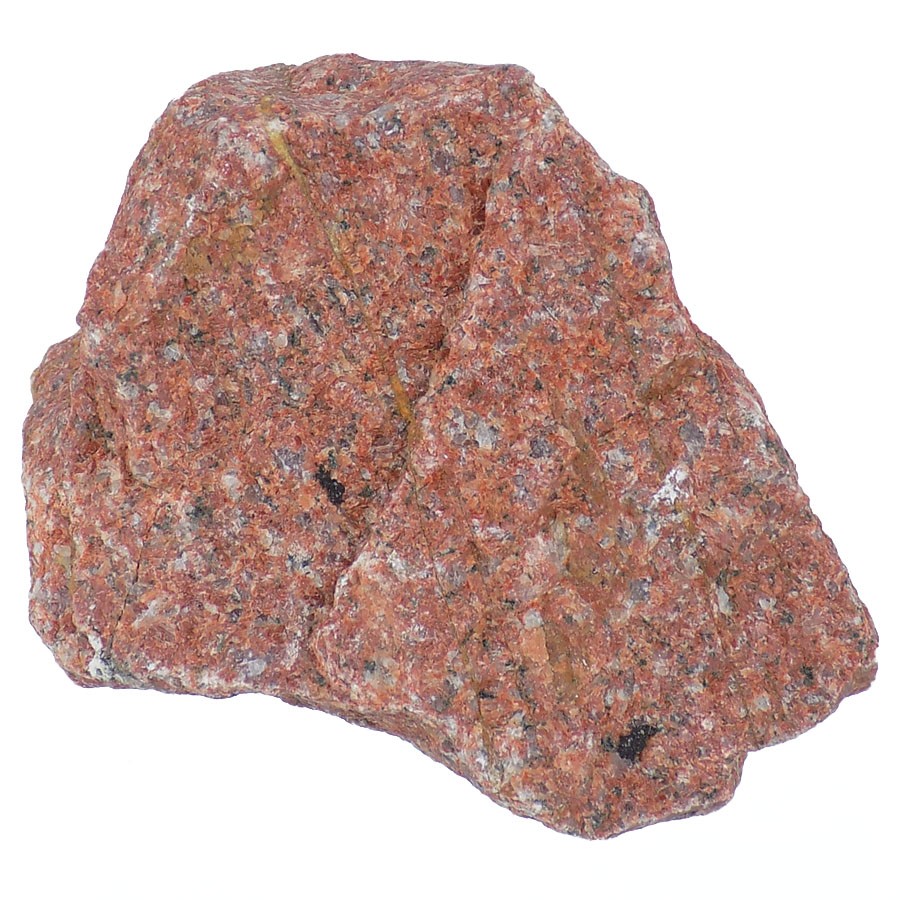Granite
Granite is the signature rock of the continents. More than that, granite is the signature rock of the planet Earth itself. The other rocky planets—Mercury, Venus, and Mars—are covered with basalt, as is the ocean floor of Earth. But only Earth has this beautiful and interesting rock type in abundance.
Three things distinguish granite.
First, granite is made of large mineral grains (its name is Latin for "granum," or "grain") that fit tightly together. It is phaneritic, meaning its individual grains are large enough to distinguish with the human eye.
Second, granite always consists of the minerals quartz and feldspar, with or without a wide variety of other minerals (accessory minerals). The quartz and feldspar generally give granite a light color, ranging from pinkish to white. That light background color is punctuated by the darker accessory minerals. Thus, classic granite has a "salt-and-pepper" look. The most common accessory minerals are the black mica biotite and the black amphibole hornblende.
Third, almost all granite is igneous (it solidified from magma) and plutonic (it did so in a large, deeply buried body or pluton). The random arrangement of grains in granite—its lack of fabric—is evidence of its plutonic origin. Other igneous, plutonic rocks, like granodiorite, monzonite, tonalite and quartz diorite, have similar appearances.
A rock with a similar composition and appearance as granite, gneiss, can form through long and intense metamorphism of sedimentary (paragneiss) or igneous rocks (orthogneiss). Gneiss, however, is distinguished from granite by its strong fabric and alternating dark and light colored bands.

With only a little practice, you can easily tell this kind of rock in the field. A light-colored, coarse-grained rock with a random arrangement of minerals—that's what most amateurs mean by "granite." Ordinary people and even rockhounds agree.
Geologists, however, are professional students of rocks, and what you would call granite they call granitoid. True granite, which has a quartz content between 20 and 60 percent and a greater concentration of alkali feldspar than plagioclase feldspar, is only one of several granitoids.
Stone dealers have a third, much-different set of criteria for granite. Granite is a strong stone because its mineral grains have grown tightly together during a very slow cooling period. Additionally, the quartz and feldspar that compose it are harder than steel. This makes granite desirable for buildings and ornamental purposes, such as gravestones and monuments. Granite takes a good polish and resists weathering and acid rain.
Stone dealers, however, use "granite" to refer to any rock with big grains and hard minerals, so many types of commercial granite seen in buildings and showrooms don't match the geologist's definition. Black gabbro, dark-green peridotite or streaky gneiss, which even amateurs would never call "granite" in the field, still qualify as commercial granite in a countertop or building.
Granite is found in large plutons on the continents, in areas where the Earth's crust has been deeply eroded. This makes sense because granite must cool very slowly at deeply buried locations to produce such large mineral grains. Plutons smaller than 100 square kilometers in the area are called stocks, and larger ones are called batholiths.
Lavas erupt all over the Earth, but lava with the same composition as granite (rhyolite) only erupts on the continents. That means that granite must form by the melting of continental rocks. That happens for two reasons: adding heat and adding volatiles (water or carbon dioxide or both).
Continents are relatively hot because they contain most of the planet's uranium and potassium, which heat their surroundings through radioactive decay. Anywhere that the crust is thickened tends to get hot inside (for instance in the Tibetan Plateau).
And the processes of plate tectonics, mainly subduction, can cause basaltic magmas to rise underneath the continents. In addition to heat, these magmas release CO2 and water, which helps rocks of all kinds melt at lower temperatures. It is thought that large amounts of basaltic magma can be plastered to the bottom of a continent in a process called underplating. With the slow release of heat and fluids from that basalt, a large amount of continental crust could turn to granite at the same time.
Two of the most well-known examples of large, exposed granitoids are Half Dome and Stone Mountain.
Students of granites classify them in three or four categories. I-type (igneous) granites appear to arise from the melting of preexisting igneous rocks, S-type (sedimentary) granites from melted sedimentary rocks (or their metamorphic equivalents in both cases). M-type (mantle) granites are rarer and are thought to have evolved directly from deeper melts in the mantle. A-type (anorogenic) granites now appear to be a special variety of I-type granites. The evidence is intricate and subtle, and the experts have been arguing for a long time, but that is the gist of where things stand now.
The immediate cause of granite collecting and rising in huge stocks and batholiths is thought to be the stretching apart, or extension, of a continent during plate tectonics. This explains how such large volumes of granite can enter the upper crust without exploding, shoving or melting their way upward. And it explains why the activity at the edges of plutons appears to be relatively
On the grandest scale, granite represents the way the continents maintain themselves. The minerals in granitic rocks break down into clay and sand and are carried to the sea. Plate tectonics returns these materials through seafloor spreading and subduction, sweeping them beneath the edges of the continents. There they are rendered back into feldspar and quartz, ready to rise again to form new granite when and where the conditions are right. It is all part of the never-ending rock cycle.
Power by Enlink Trading Co. Pvt Ltd
Designed and Developed by Shopweb